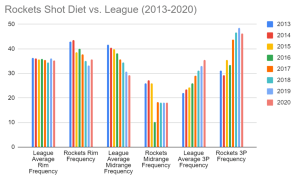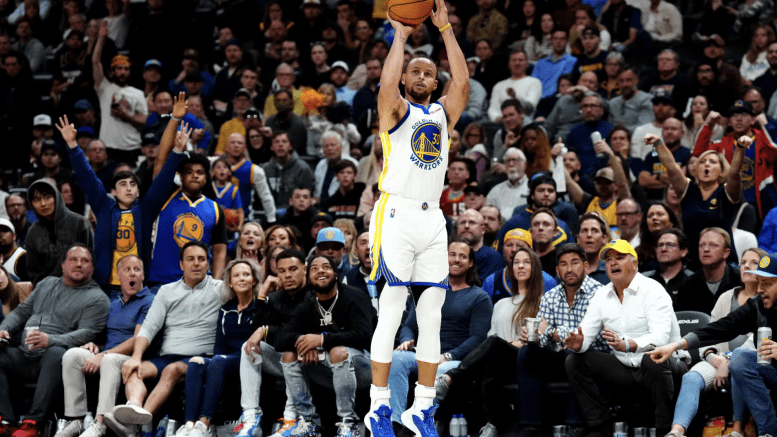Authors: Ascher Levin, Vaibhav Rangan, Charlie Spungin, Jack Tully
ascherlevin2026@u.northwestern.edu, vaibhavrangan2027@u.northwestern.edu, charliespungin2027@u.northwestern.edu, jacktully2026@u.northwestern.edu
Three-pointers have become necessary to win games in the NBA. In the 1999-2000 season, teams averaged 13.7 three-point attempts per game. Today, the Los Angeles Lakers attempt the fewest threes per game; however, they take 30.4 per game. In this article, we will look at the impact of three-pointers in the last ten years.
This revolution first began in the mid-2010s with the birth of the Golden State Warriors dynasty led by Stephen Curry and Klay Thompson, nicknamed “The Splash Brothers.” Perhaps the two greatest shooters to grace the planet, the Warriors dynasty made six NBA finals (2015-2019, 2022) and won four of them (2015, 2017, 2019, 2022).
The rest of the league saw the Warriors assemble some of the greatest teams in NBA history with three-point shooting at the core of their identity. Throughout basketball history, dominant, interior-based centers were often, although not always, the stars of their teams. The Warriors inspired a major shift in teams focusing on guards and shooters to bring forth winning.
Between 2015 and 2019, the Warriors had the league’s top offense three times and finished no lower than third in Offensive Rating (the number of points a team scores per 100 possessions). Similarly, between those years, they led the league in 3PT% three times and finished no lower than third. Their volume from long range was amongst the highest each year as well.
During the Warriors’ record-setting 73-win season in 2016, they shot a blazing 41.6% from beyond the arc, on 31.6 attempts per game. This volume led the league in 2015-16, but this would rank just 24th this season!
In today’s NBA, it is no longer viable to have two or more non-shooting threats on the floor. Think back to the mid-2010s when the Detroit Pistons would play Greg Monroe next to Andre Drummond. Those days are no more, although current Pistons coach Monty Williams may disagree, routinely placing multiple non-spacers on the floor together. It should be no surprise that they are in the bottom third of teams in terms of their 3PT% and 29th in attempts.
Having the ability to space the floor goes beyond simply generating more threes. Good shooting players have gravity, leading to opposing defenses not wanting to help off of them. This opens up the floor for that player’s teammates to get to the basket, midrange, and run other various sets, such as pick & rolls.
Video by NBA Advanced Stats
Take the above play for example. Klay Thompson (37.1 3PT%, career 41.3%) runs off two pindowns from Stephen Curry and Jonathan Kuminga. Due to the fear of an open three due to Spencer Dinwiddie’s poor defense, Nic Claxton closes out on Thompson, effectively sending two to the ball and leaving Kuminga wide open. Mikal Bridges doesn’t want to help off of Stephen Curry (41.0 3PT%, career 42.6%) in the corner, and it’s a Kuminga dunk. Note the gravity of Thompson and Curry.
However, Moreyball, a catch-all term for a point-per-possession centric approach to shot selection, faces highly visible pitfalls. The 2018 Rockets shot almost exclusively three-pointers and layups, eliminating the midrange shot from their diet and despite shooting a relatively modest percentage from deep, they broke several scoring records based on sheer volume of three-point attempts.
In a “win-or-go-home” Game 7 of the 2018 Western Conference Finals against the Warriors, the Rockets missed 27 straight threes. Even more inexplicable than the number of misses from deep was the Rockets’ persistence in putting up threes as opposed to diversifying their shot selection to include mid-range shots that the Warriors were inviting Houston to take.
In each season between 2013 and 2020, the Rockets ranked dead last in the league in midrange frequency, according to Cleaning the Glass. On the flip side, their 3PT frequency was first in six of those eight seasons. The two times they weren’t first? They were second. It is important to note, though, that they never were a team that was elite at shooting the ball; over this eight year stretch, their highest 3PT% as a team was at 36.9% in 2013 and 2019 (13th in the league both seasons).

Not only is the league’s rise in three point attempts evident, but so is the Rockets’ emphasis on taking more and more threes. In addition, their low midrange frequency is rather evident, as they were always miles below league average.
This emphasis on three-point shooting clearly led to wins for the Rockets, they never finished below .500 between 2013 and 2020 and exceeded 50 wins five times, reaching 65 wins in 2017-18. In addition, they boasted a top-10 offense in each year but one over this eight year span, including four top-5 offenses.
The lesson of the Mike D’Antoni, Daryl Morey, James Harden Rockets is not that midrange shots are somehow valuable again; rather, the Rockets failed to capitalize on the schematic advantages resulting from high-volume and efficient three-point attacks. Against better shooting teams, defenses are more likely to play more aggressive pick-and-roll coverages and be more reluctant to help off wings and corners and, thus, concede more drives and midrange shots and consequently increase the points-per-possession of previously inefficient shots.
As for how three-pointers are affecting the game this year, the teams that have made and attempted the most have correlated with higher winning percentage (the opposite is also true). For example, the Boston Celtics have the best winning percentage. They also have the most three-pointers made and attempted per game, nailing 16.2 triples on 42.9 attempts this season. The Celtics are taking 2.4 more triples than the next highest team, the Mavericks. Even while leading the NBA by a large margin in attempts, the team is doing it effectively, as the Celtics are fifth in 3PT% at 37.9%. The Celtics have clearly leaned into the three-point shot, and it is paying dividends for them.
On the other side of the spectrum, the historically bad Detroit Pistons are near the bottom of the league in attempts and makes. The Pistons average 11.1 threes made per game on 31.1 attempts. Both of these statistics are bottom two in the league. While they aren’t a great three-point shooting team at 35.6% (bottom seven in the league), it would be advantageous for them to ramp up their number of attempts.
Overall talent plays a factor in the number of open looks that teams get. The Pistons might not have as many good looks because of poor spacing and a lack of quality shooting options. However, in recent years, statistical data has consistently demonstrated that a greater number of three-point makes and attempts correlates positively with overall team success.

Terrific, well written and infomative article !